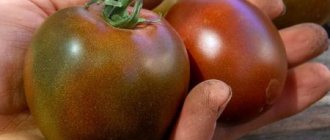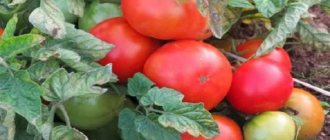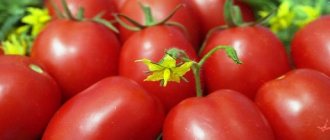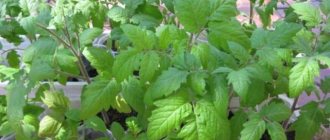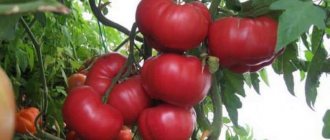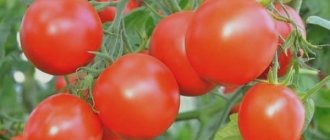The Black Pineapple tomato is called exotic because of its unusual color. Thanks to its excellent taste and rich harvest, tomato is found in the beds of modern vegetable growers almost as often as the usual large-fruited varieties.
| Height | Landing location | Ripening time | Fruit color | Fruit size | Origin | Fruit shape |
| Tall | Greenhouse | Mid-season | Bicolor | Large | Variety | Flat-round |
Description and characteristics of the variety
An indeterminate plant intended for cultivation exclusively in greenhouse conditions. For the first time, the variety began to be actively used in Belgium. The bush reaches 180 cm in height, formed into 2-3 stems. With proper care it produces a rich harvest.
Features of cultivation and care
To successfully grow Black Pineapple, it is recommended to use seedlings. Seeds are sown in March - April, approximately 60 days before planting. Before planting them, it is recommended to treat them with a manganese solution; you can additionally use a growth stimulator. For planting, any convenient containers are suitable, into which soil is poured with the following composition:
- soil from the garden;
- peat;
- washed river sand;
- wood ash.
It is necessary to make 1 cm grooves in the resulting soil, place seed material and sprinkle with soil.
Before the first shoots appear, containers with seedlings are covered with film or glass. The average temperature regime for plants should be in the range of +25 - +27°C. After the seedlings sprout, this indicator is lowered by 7 degrees, and the containers are moved to a room with good lighting.
Note to the gardener. Tomatoes should be planted in the place chosen for them after the spring frosts have ended. The planting density should not exceed 2 - 3 bushes per 1 m². For tomatoes, beds where carrots, zucchini, and cucumbers were previously planted are suitable, but it is better not to plant where representatives of the nightshade family grew.
It is necessary to leave a free space of 0.4 meters between the bushes, and 0.6 m between the rows. Thanks to this distance, all plants will receive solar heat.
After planting, it is necessary to water the tomatoes and mulch the soil to retain moisture in the ground. Tomatoes need feeding; organic fertilizers or mineral complexes are used here, and this is done 3–4 times per season.
Advantages and disadvantages
Pros:
- suitability for transportation;
- high productivity;
- incredible tomato color;
- taste qualities;
- long-term storage at low temperatures.
Minuses:
- regular fertilizing with mineral fertilizers is required;
- constant garters and installation of supports for shoots are necessary;
- sensitive to changes in temperature and humidity (in rainy weather the fruits become more sour);
- not suitable for preservation due to the large size of the fruit;
- Regular removal of stepchildren is necessary.
Description of tomato Black pineapple
- February 27, 2021 10:38:00
The Black Pineapple tomato is an exquisite and productive variety, famous for its original taste and unusual coloring of tomatoes. Breeders have been working on the dark color of fruits for a long time, and now this variety pleases the eye with its unusual appearance and is distinguished by its high yield.
As for the description of the Black Pineapple tomato, this sunny vegetable is collected from a bush up to 1.4 meters high in mid-summer. The bushes grow tall, branch well and form a lot of foliage - they form a straight trunk, so they need to be tied to a support and supports used under the clusters of ripening fruits.
Reviews of the Black Pineapple tomato are mostly positive. To ensure good yield, the tomato bush is pinched - this is the name for eliminating unnecessary side shoots and leaves. The bush is formed into two or three branches, and all leaves below the brush are removed.
The fruits are flat-round, slightly ribbed and weigh up to half a kilogram each. They are meaty and pleasant in taste; the skin is thick and does not crack due to sudden changes in temperature. Ripe fruits have an unusual purple color, and the pulp combines green, yellow and red shades. The colored mosaic that forms on the cut of a tomato is also pleasing to the eye. The taste of the Black Pineapple tomato variety is much better than that of its red competitors.
Advantages and disadvantages of the Black Pineapple tomato
The fruits tolerate long-term transportation and can be stored at low temperatures. It is noted that the sunny vegetable is not suitable for preservation, but in salads it has an amazing taste and an extremely original appearance.
The disadvantages of the variety include the fact that it requires garter, and it is necessary to properly form the tomato bushes. Black pineapple tomato requires regular feeding - in rainy weather the fruits become more sour. The fruits contain an increased amount of sucrose and a harmonious combination of sugar and acid. This is what gives them such an extraordinary taste. Anthocyanins contained in fruits neutralize free radicals in the body and have a cleansing effect. These substances increase the protective properties of the human immune system, strengthen the internal walls of blood vessels and eliminate swelling.
Black Pineapple Tomatoes, photos of which can be seen on the website, contain a large amount of lycopene, which has a positive effect on the prostate gland. And the increased content of carotene can significantly improve vision. Such tomatoes are also considered aphrodisiacs, which improve the sexual function of a man’s body.
Features of growing tomato Black pineapple
Soils with low acidity are suitable for growing vegetables; higher acidity levels are neutralized with lime. This year, areas where cucumbers, carrots, cabbage, or onions previously grew are suitable for growing vegetables. Humus, superphosphate and wood ash are added to the soil before planting. To grow them, be sure to make the soil light and nutritious - then there will be no problems with the harvest.
Much of the yield depends on proper cultivation of seedlings. The seeds are disinfected with a weak solution of potassium permanganate and planted in special pots for seedlings. They must have holes for free flow of water. The seeds are buried one centimeter and watered well.
After twenty days, the plants will germinate and then become stronger; they need to be watered every three days and provided with sunlight. It is necessary to ventilate the room where the plants are located, and after a month or a month and a half, transplant the seedlings into a greenhouse. Before planting, humus is added to the hole - the plants cannot be fed with fresh manure, it causes burns to the root system. For good fruiting, leave from two to five fruiting clusters on the bush. Then the harvest of sunny vegetables will delight the gardener with a high yield. You can buy Black Pineapple tomato seeds on the Royal Garden website.
Productivity
Each fruit is large in size - 500-700 g. From one bush you can get about 8 kg of yield, which is not bad for indeterminate varieties of tomatoes. Considering that tomatoes are formed into several bushes at once, at the time of harvest the vegetable grower will not be disappointed with the result obtained.
To increase yield, prune from the first cluster that begins to flower. By leaving a certain number of brushes, you can adjust the size of the fruit. With 2 clusters left, the fruits will be gigantic in size - almost up to 1 kg. With 5 bunches the tomatoes will be smaller.
How to grow tomatoes
Before planting seedlings in a garden bed or greenhouse, they need to be hardened off. To do this, it is enough to leave the windows open at night.
Landing
Tomatoes are planted in open ground at the end of May or beginning of June, when they are no longer threatened by frost. By this time, the plant already has a strong stem and at least 5 leaves.
Before transplanting tomatoes, you need to prepare the soil:
- Rake the ground.
- Make holes at a distance of 30 cm.
- Fertilize each hole with 1 tablespoon of superphosphate.
- Water each hole.
When the soil is ready for replanting, you need to:
- Stick a peg next to each hole, which will become a support for the bush.
- Before planting, water the hole again and plant the sprout along with soil from a cup.
- Next, the plant is lightly compacted with earth and watered.
Care
After the plant has been transplanted into a garden bed or greenhouse, it must be cared for as carefully as seedlings on a windowsill.
Basic procedures:
Loosening. During the first time after replanting the plant, it is necessary to monitor the condition of the soil and prevent it from cracking. When the plant takes root and gets stronger, the soil can be loosened once every 4 days.
Watering. When watering, water should not fall on the plant. While the tomato bush is growing, the frequency of watering is increased, and when the first fruits appear, it is reduced. Tomatoes are watered with relatively warm water; cold water can chill the roots, which will lead to the death of the plant.
Feeding. Two weeks after transplantation, the tomato must be fed with a mixture of: saltpeter, urea, superphosphate and potassium salt. Three weeks later, the procedure is repeated.
Weeding is carried out every 14 days in parallel with loosening. You need to weed the bed manually. Removing weeds promotes good plant growth and productivity.
Planting a plant is one of the important activities that must be carried out at all stages of development. Pinching is the removal of side shoots from a plant. This can be done using pruning shears or manually. It is advisable to do this before the shoot grows to 5 cm, then it will injure your plant less. Before you start removing unwanted shoots, decide how many stems you want to grow the bush. If it is 2-3, then the growth of young shoots must be stopped in time.
Bush formation. One of the main questions when growing the Pineapple variety is how many stems to grow. Tall varieties, which include the Pineapple tomato, grow in one stem. To do this, we form a bush using the pinching method already known to us.
When choosing a method for forming a bush, also do not forget about such an important factor as climatic conditions. Tomato garter is a must
Pineapple belongs to tall varieties, has delicate and weak stems that can break both under their own weight and under the weight of ripening varieties
Gartering tomatoes is a must. Pineapple belongs to tall varieties, has delicate and weak stems that can break both under their own weight and under the weight of ripening varieties
A tied plant is easier to water and loosen. Tomato garter also protects its fruits from pests and various diseases.
With proper care, the plant will delight you not only with stable growth and development, but with excellent productivity.
Taste qualities
The tomato has a sweet citrus taste and amazing aroma. Suitable for eating raw, making salads or various snacks. Black Pineapple combines the best of green and dark-fruited tomatoes. The shape of the tomatoes is flat-round with slight porosity. The skin of a ripe tomato is dense and does not crack. Color - brownish with a purple tint.
The tomato pulp is sugary, practically without seeds. The pulp does not have a single color - it can be pink, red, green or yellow.
To obtain a dark skin color, breeders crossed wild tomatoes with red varieties. Then the darkest-colored hybrids were selected for further selection.
Soil preparation
When growing, an important point is the preparation of the soil. A lot depends on this procedure. The main point is the subacidity of the soil. For the most part, all varieties of this crop prefer vaudeville soil, and Black Pineapple is no exception.
In any case, if the acidity of the soil is excessively high, it will have to be limed for about three years. Only after this time can the buttocks be planted.
When planting in open ground, take into account the fact that under no circumstances should the sample be planted immediately after eggplants, potatoes or sweet peppers.
It is advisable to add humus or peat to the soil. With the intention of avoiding further diseases of tomatoes, it is frozen before applying fertilizers for a certain period. For the successful development of tomatoes, they need to be fed with the following preparations:
- Peat.
- Wood sawdust.
- A small amount of ash.
- Humus.
- Organic fertilizers.

